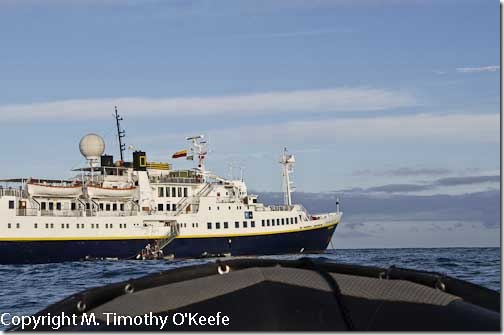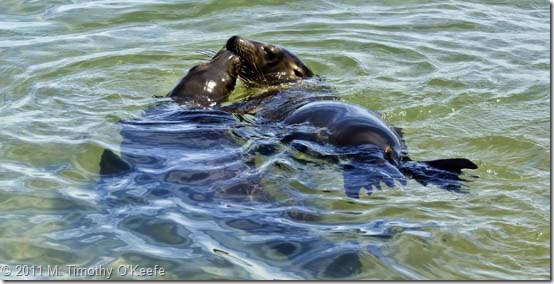
Lindblad Expedition’s “National Geographic Endeavour”
Normally it’s impossible on the same day to snorkel with such cold water animals as penguins and fur seals and at the same time encounter typically warm water reef fish like Moorish idols and the red-colored squirrelfish and soldierfish. Cold and warm water marine animals usually are found thousands of miles (and thousands of dollars) apart … except in the fabled Galapagos Islands.
Even more intriguing are the Galapagos’ fascinating land animals, particularly the giant tortoises, marine and land iguanas and the blue-footed boobies. Overall, at least one‑third of the land species inhabiting the Galapagos Islands are found nowhere else in the world.
Linda and I are about to see them all, up close, on a 7-day cruise aboard Lindblad’s National Geographic Endeavour. This cruise fulfills a photographic wish we’ve shared for some time. Although I was fortunate enough to cross off the Galapagos from my bucket list a number of years ago, I’ve wanted for a long time to return and replace my deteriorating film slides with digital images. And, to be honest, I’ve forgotten so much about the trip that a second time for me should feel more like a first visit.
More than most cruise destinations, the Galapagos require some background information before departure. Not only to help you plan in advance on what precisely to bring (you won’t have time or the opportunity for anything but souvenir shopping) but to make sure you’ve chosen a time of year that you can be happy with.
 Sea lion pups playing only yards from the shoreline.
Sea lion pups playing only yards from the shoreline.
The Galapagos, harsh volcanic islands located on the equator 600 miles off the coast of Ecuador, were named the “Mysterious Isles” by the first Spanish explorers. The archipelago is far more than “mysterious;” they are like nowhere else on earth. Many of the land animals‑‑like the 3‑foot long, dinosaur‑like iguanas and huge land tortoises‑‑were so isolated from the South American mainland that they and others developed in ways distinctly apart from their nearby cousins.
The Galapagos climate is largely determined by Pacific Ocean currents that cut through the archipelago, made up of 13 main islands along with numerous islets and rocks. The colder, dominating Humboldt Current (also called the Peru Current) streams in from Antarctica, following north toward the equator from the southern tip of Chile to northern Peru. The Humboldt current, which upwells deep water to the surface, is responsible for making the water as chilly as 63 F during the June-December months. The cold, nutrient-rich water also supports one of the world’s most productive fisheries, primarily pelagics, jack mackerel, anchovies and sardines.
The cold Humboldt stream keeps the air temperatures surprisingly moderate year-round, from 69F (21C) to 84F (30C). It also helps create the annual rainy season (January through May). The rains, however, are brief and the sun shines most of the time. Sounds ideal, except the rain brings out the mosquitoes and flies, which can be fierce. In addition, the rains also make the water murkier for snorkeling and may also produce a sea mist.
During the remainder of the year, the skies are often overcast until midmorning, sometimes all day, under the influence of what is called the garua. You’ll actually see more sunlight during the rainy period, but that is the least strange element in this land overlooked by time.
This cold water upwelling of the Humboldt Current periodically is disrupted by an El Nino event, which brings a rush of warm, nutrient-poor tropical water, sometimes pushing the water temperatures as high as 86F. The Galapagos is strongly influenced by the El Niño events that occur every 2-7 years with either a warm (El Niño) or a cool (La Niña). Strong El Niño events cause higher than normal sea surface and air temperatures in the January-May hot season along with an increase in rainfall; these months also make up the rainy season. Biological productivity increases on land during such periods but high water temperatures cause a 50% mortality among the seal and marine iguana populations, which survive on the plants, fish and invertebrates found in shallow water. The La Niña events cause lower than normal sea surface and air temperatures and reduce the rainfall amount in the normally wet, hot season of January through May. Reduced rainfall can also lead to drought, severe food shortages and mortality among the land animals.
As an example, Charles Darwin Research Station on Santa Cruz Island records that the median rainfall there is 7.62 inches (196 mm) in the rainy season and only 3.2 inches (81mm)in the cool season (June through December). In an extreme El Nino event, the rainfall has increased to 109 inches (2769 mm); during a La Nina extreme, it has fallen to just 2.4 inches.
| Months | Low Temp | High Temp | Season | Water Temp |
| Jan – May | 65 – 70°F | 85 – 90°F | wet | 75 – 82°F |
| June – Dec | 65 – 70°F | 85 – 90°F | dry | 62- 68°F |
Our October cruise is during the cloudy garua season and a time of cold water; we’re relying on the digital cameras to compensate for the cloudy weather. Hopefully, they will do the job since it is no longer possible to use flash on the animals. About the cold water, though, we’re not so sure. As Floridians, Linda and I try to avoid it. We expect to tough it out, though, even investing in a couple of the new Nikon Coolpix AW100 point-and-shoot digitals capable of going down to 33 feet. That’s deeper than we expect to snorkel.
Lindblad Endeavour Galapagos Cruise Links
The Galapagos Experience Endeavor Dining
Galapagos Adventure Upcoming Sustainable Dining Policy
How Darwin Saved The Galapagos Saturday Dining Menus
Galapagos Photo Tips Sunday Dining Menus
What To Pack For Cruise Monday Dining Menus
Getting to Guayaquil Tuesday Dining Menus
Las Bachas Shore Landing Wednesday Dining Menus
North Seymour Shore Landing Thursday Dining Menus
Fernandina & Isabela Islands Friday Finale Menus
Urbina Bay Shore Landing Endeavour Recipes
Life Aboard The Endeavour
More About Life On Board
Puerto Egas Shore Landing
Endeavour’s Floating SPA
Meeting One of World’s Rarest Animals
Puerto Ayoro Walking Tour
Santa Cruz Highlands Tour
Hunting Tortoises in the Santa Cruz Highlands
San Cristobal, Endeavour’s final stop

 Follow
Follow